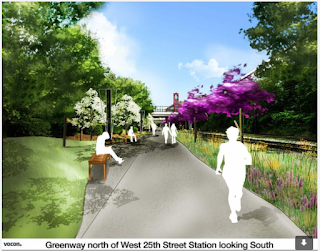 |
| Preliminary site plan for Solove Real Estate's high-end market- rate apartment complex on Detroit Avenue east of Bunts Road in Lakewood. (BBCO Design)(Click to enlarge all images) |
Real estate developer Jerry Solove of Columbus knows it all too well. His son spent the past year looking to buy or rent a home in Lakewood. Solove and his son learned that quality homes sell within a day or two of being listed with a realtor, with some prices bid upward in all-cash deals. Solove recalled seeing a renovated bungalow for sale this summer on Mathews Avenue, behind the Around The Corner Saloon. It was listed in the evening and, before the sun rose again, it was already under contract by a buyer.
Experiences like this are one reason why Lakewood housing prices rose 22.5 percent, highest among all Cuyahoga County communities in 2018. Another reason for the price spike is that Lakewood has lost more than 1,700 housing units since the 1980s due to demolitions of housing and conversions of rental doubles into single-family, for-sale homes.
Lakewood housing inventory is limited. Only East Cleveland's housing stock is older than Lakewood's in the county. Another reason for the price spike is the growing interest by Milennials and Baby Boomers, the two largest generations in U.S. history, in downsized housing in walkable settings -- something that the streetcar suburb of Lakewood touts. And still another reason is that the Greater Cleveland's economy has picked up significant momentum in recent years, adding jobs faster than all but 15 other metro areas.
 |
| Columbus developer Jerry Solove addresses a Nov. 27 public meeting about his proposed Lakewood project. (Prendergast) |
"But we spent a year trying to find a home," Solove said at a public meeting at Lakewood City Hall on Nov. 27. "The community need is for more single-level housing. We intend to focus on two category of residents. First are people just starting their careers and families, and earning $45,000 to $85,000 or more. Second, we want to serve empty-nesters who don't want to climb stairs."
His Columbus-based firm, Solove Real Estate, is proposing to build an apartment complex with 278 housing units in two mid-rise buildings, a 375-space parking garage plus a pocket park and a rooftop lounge on the site of the former Spitzer Lakewood Chrysler dealership at 13815 Detroit Ave. and neighboring Educators Music. The development plan is at a conceptual stage, called a massing, and will be refined with more input.
 |
| Conceptual plan of proposed development. Above, this view looks south from Detroit Avenue. Below, the view looks northward toward Detroit Avenue. (BBCO Design) |
The preliminary idea is to have a five-story parking garage with an entry off Parkwood and fronted by apartments on Detroit with a one-story amenity building south of the parking garage. The building west of Parkwood would be eight stories of apartments and a public pocket park. All servicing (utilities, waste, etc) would be off Bunts, Detroit and Wyandotte.
The public meeting was the first step in a four- to six-month-long city review process that will start in January or February and be shaped by public input, traffic studies, market data and the city's existing development masterplan called Community Vision. That plan, updated most recently in 2017, has these guiding principles for housing:
- A housing market that is stable and provides for moderate growth in housing values.
- Adequate housing opportunities for the city’s economically and culturally diverse residents.
- A high-quality housing stock that is diverse in style and is well maintained through proactive code enforcement and community home improvement programs.
It can be argued that this proposed development responds to all of these masterplan goals by helping to address the shortage of quality, contemporary housing that is, in part, causing Lakewood housing prices to spike and taxes to rise.
"We work hard for urban development," Solove added. "We try to have pedestrian-friendly communities. The attention to detail is very important to us. We have a good retention rate and we take a lot of pride in what we do."
Solove has a purchase agreement with Spitzer Lakewood Chrysler Plymouth and a partnership with Stavash Family LLC. The buildings on those parcels will be demolished. The Stavash family, which has owned Educators Music since it opened in 1960, sold their company to two partners on Oct. 4, according to the Ohio Secretary of State's website. The two partners, Scott McDermott and Bill Craighead, introduced themselves at the Nov. 27 meeting.
Attempts by Solove to purchase the 0.35-acre parcel used by Bruce's Automotive & Fleet Services, 13919 Detroit Ave., were rejected by George Shaker. He owns G & M Property Management 3 LLC, which in turn owns the property leased by Bruce's Automotive.
"We tried to incorporate Bruce's but he (Shaker) wants nothing to do with that," Solove said.
One of the early steps would involve rezoning the roughly two acres of land from C-3 Commercial to Planned Development, said Bryce Sylvester, the city's director of planning and development. Solove said he is not seeking any public subsidies from the city for this development -- a testament to the strength of Lakewood's real estate market.
"Bill (Craighead) and I drove to Columbus to see Solove's developments first-hand," McDermott said. "I was impressed with Solove's developments. This (Lakewood project) is a market-driven development. It will fill quickly."
The goal is to start construction in 2019 and open in the Spring of 2021, Solove said.
END


















